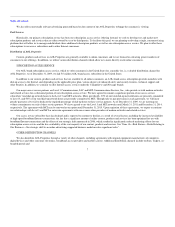America Online 2009 Annual Report Download - page 21
Download and view the complete annual report
Please find page 21 of the 2009 America Online annual report below. You can navigate through the pages in the report by either clicking on the pages listed below, or by using the keyword search tool below to find specific information within the annual report.
Table of Contents
Even if we are able to attract new consumers to, and generate increased engagement on, AOL Properties, we may not be able to maintain or increase our
advertising revenues associated with AOL Properties.
Different AOL Properties generate varying volumes of advertising that are sold at a range of prices. To the extent our consumers are active on AOL
Properties where we do not deliver a high volume of advertisements or high-priced advertisements, we are limited in our ability to generate advertising
revenues from such activity. Accordingly, if we are not able to attract and engage consumers to those AOL Properties that typically generate higher-priced
and higher-volume advertising, our advertising revenues may not increase even if the aggregate number of consumers on AOL Properties increases and their
aggregate engagement increases.
Our restructuring actions may not deliver the expected results and these actions may adversely affect our business operations, particularly in the near
future.
We undertook various restructuring activities in 2009 and the first quarter of 2010 in an effort to better align our organizational structure and costs with
our strategy. As part of our restructuring activities we implemented voluntary and involuntary separation programs which we expect to result in the reduction
of nearly one-third of our workforce, prior to hiring of new employees in areas of strategic focus. Certain employees who participated in the voluntary
separation program have unique and specific areas of expertise which are important to our strategic objectives. Even if we are able to attract new personnel to
replace these key employees, we may still experience a disruption in our ability to perform functions critical to our strategy given the significant reduction in
the number of our employees. While we strive to reduce the negative impact of the departure of such a large number of our employees, this reduction could
result in significant disruptions to our operations, particularly in the near future, including adversely affecting the timeliness of product releases, the successful
implementation and completion of our strategic objectives and the results of our operations.
We face intense competition in all aspects of our business.
The Internet industry, with its low barriers to entry and rapidly shifting consumer tastes, is dynamic and rapidly evolving. New and popular
competitors, such as social networking sites, online advertising businesses and providers of communication tools, quickly emerge. Competition among
companies offering advertising products, technology and services, and aggregators of third-party products and services, is intense. Internationally, we face
intense competition from both global and local competitors. In addition, competition may generally cause us to incur unanticipated costs associated with
research and product development.
The competition faced by our subscription access service, especially from broadband Internet access providers, could cause the number of our
subscribers to decline at a faster rate than experienced in the past. Dial-up Internet access services do not compete favorably with broadband access services
with respect to connection speed and do not have a significant, if any, price advantage over certain broadband services. Many broadband providers, including
cable companies, bundle their offerings with telephone, entertainment or other services, which may result in lower prices than stand-alone services. Based on
customer survey information, the majority of our canceling access subscribers either already has broadband Internet connections or is leaving for broadband
Internet connections. Broadband penetration of U.S. households increased from 28% in 2004 to 69% in 2009 and the number of U.S. households with dial-up
access decreased from approximately 44 million in 2004 to 10 million in 2009. In addition to competition from broadband providers, competition among dial-
up Internet access service providers is intense.
There can be no assurance that we will be able to compete successfully in the future with existing or potential competitors or that competition will not
adversely affect our business.
Weak economic conditions could adversely affect our revenues.
The global economy has been in a recession, and the future economic environment may continue to be less favorable than that of recent years. These
weak economic conditions could lead to further reduced advertising
17
























